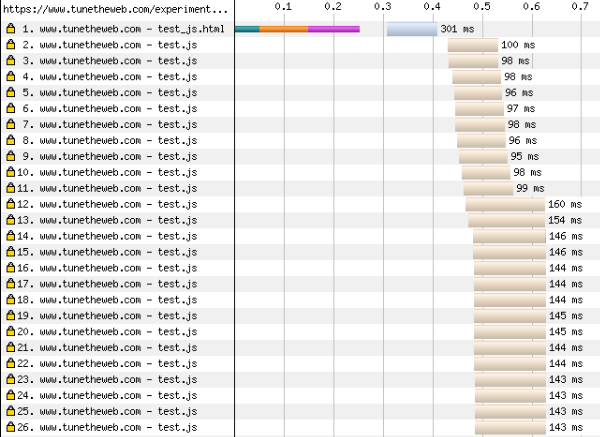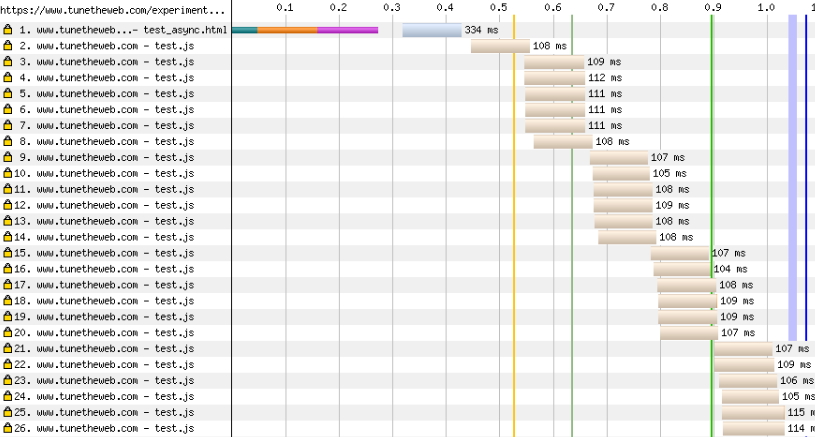I think this is a bug in Chrome, or at least a needless restriction.
This is easily tested.
I created a simple example HTML file, which downloads 25 copies of the same javascript file (with a query param to make it look like a different resource):
<!DOCTYPE HTML>
<html>
<head>
<title>Test for Lots of JS files</title>
<meta name="robots" content="noindex">
<body>
</body>
<h1>This is a test for Lots of JS files</h1>
<script src="/assets/js/test.js?v=01"></script>
<script src="/assets/js/test.js?v=02"></script>
<script src="/assets/js/test.js?v=03"></script>
<script src="/assets/js/test.js?v=04"></script>
<script src="/assets/js/test.js?v=05"></script>
<script src="/assets/js/test.js?v=06"></script>
<script src="/assets/js/test.js?v=07"></script>
<script src="/assets/js/test.js?v=08"></script>
<script src="/assets/js/test.js?v=09"></script>
<script src="/assets/js/test.js?v=10"></script>
<script src="/assets/js/test.js?v=11"></script>
<script src="/assets/js/test.js?v=12"></script>
<script src="/assets/js/test.js?v=13"></script>
<script src="/assets/js/test.js?v=14"></script>
<script src="/assets/js/test.js?v=15"></script>
<script src="/assets/js/test.js?v=16"></script>
<script src="/assets/js/test.js?v=17"></script>
<script src="/assets/js/test.js?v=18"></script>
<script src="/assets/js/test.js?v=19"></script>
<script src="/assets/js/test.js?v=20"></script>
<script src="/assets/js/test.js?v=21"></script>
<script src="/assets/js/test.js?v=22"></script>
<script src="/assets/js/test.js?v=23"></script>
<script src="/assets/js/test.js?v=24"></script>
<script src="/assets/js/test.js?v=25"></script>
</html>
I then did the same, but adding the async attribute, in case Chrome decide to block downloading while processing the Javascript:
<script src="/assets/js/test.js?v=01" async=""></script>
<script src="/assets/js/test.js?v=02" async=""></script>
....etc.
and the same again but with the defer attribute:
<script src="/assets/js/test.js?v=01" defer=""></script>
<script src="/assets/js/test.js?v=02" defer=""></script>
....etc.
The /assets/js/test.js file was empty. So there would be no execution delays, nor dependencies except those that the browser added.
I saw some interesting results! This is all with Chrome 60.0.3112.78 or 60.0.3112.101, and I'm using Apache, but saw same results as you saw for Nginx.
With an HTTP/2 server we see the following results:
With a plain script tag all the scripts are loaded in parallel (but presumably executed in order). There is no 6 connection limit as under HTTP/1.1:
![Javascript with no async or defer]()
With an async script tag the scripts are loaded in parallel in groups of 6 - exactly as you noted:
![Javascript with async]()
Clicking on them shows they WERE downloaded over HTTP/2.
With a defer script tag the scripts is the same as the results for using the async tag - a throttling to 6 downloads at a time.
This does not make sense - Chrome is restricting your Javascript downloads, but only if you use async or defer to improve your downloads from blocking rendering!
As sbordet stated, the same does not happen for images in the viewport - so multiplexing DOES work on Chrome, it just appears to be needlessly limited for Javascript in async or defer mode. This is a real limitation, if you are considering not bundling scripts together any more under HTTP/2, as many advise you no longer need to do.
The same does not happen on Firefox, nor Edge. Though it does happen on Opera (a Chromium based browser).
So that's the bad news. The good news is that they "may" have fixed it. When I try Chrome Canary (62.0.3190.0) I can't repeat this behaviour. However when I use Web Page Test with Canary (which it gives 62.0.3190.1 in the user agent string, so should be practically the same) it is repeatable, so not 100% sure they have fixed this after all...
Have raised a bug with the Chrome team for this so will see what they say: https://bugs.chromium.org/p/chromium/issues/detail?id=757191
All in all, HTTP/2 on both server and client does seem a little in flux at the moment, as both sides tweak and tune their implementations to get optimal use out of this still relatively new protocol. Still, it's surprising to see Chrome hit with this since Google started this off with their SDPY implementation (which HTTP/2 is heavily based upon) so you would expect them to be ahead of the curve not behind...
** Update **
Chrome team got back and confirm this is a restriction of current implementation of HTTP/2 in Chrome. They were seeing performance issues when many assets very called at once, as HTTP/2 allows, so restrict non-critical items (including async/defer and items not visible in the viewport) to HTTP/1.1 limit of 6.
Even though HTTP/2 has concept of prioritisation of requests after they are sent, the performance issues were seen before they were prioritised and sent (e.g. checking cache, cookies... etc) so HTTP/2 prioritisation doesn't help here.
They hope to improve this in future.
So guess I was right that it's an implementation issue as we get used to the new HTTP/2 world and have to optimise our browsers and servers for it!



